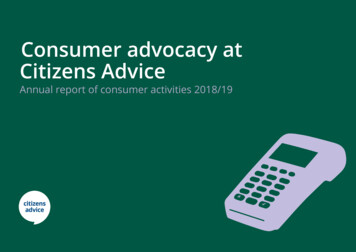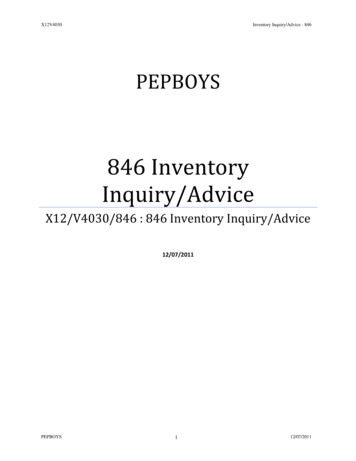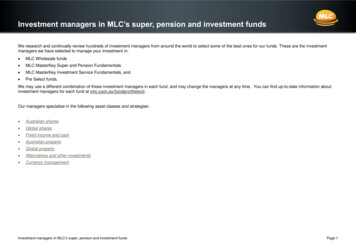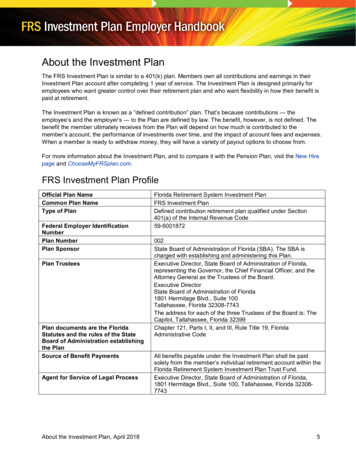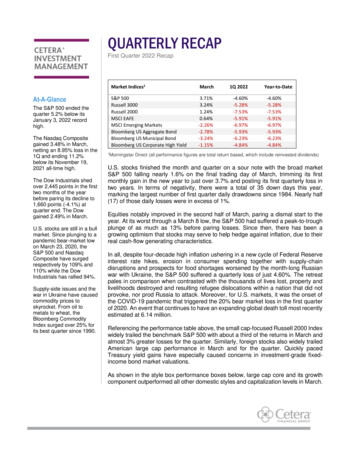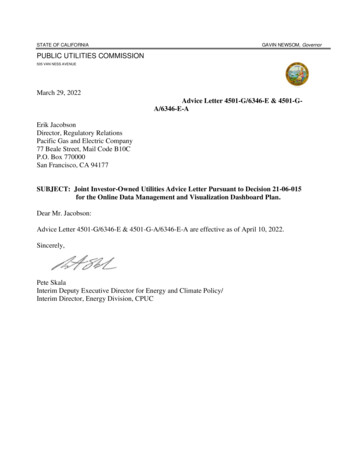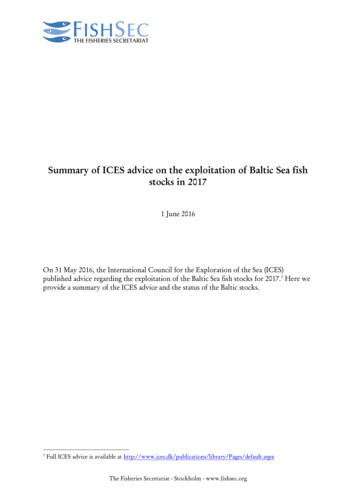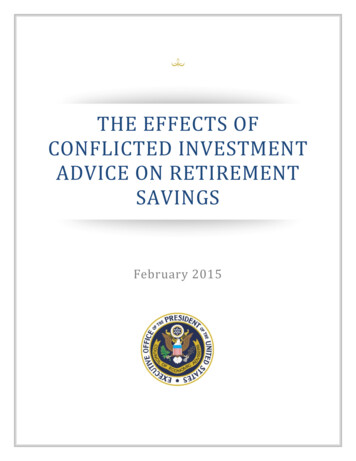
Transcription
Report on Digital Investment AdviceMARCH 2016A REPORT FROM THE FINANCIAL INDUSTRY REGULATORY AUTHORITYContentsIntroductionIntroduction1A Note on Terminology2A Brief History of DigitalInvestment Advice2Governance and Supervision3Investor Profiling8Rebalancing11Training12Lessons for ogy has long played a central role in financial services innovation. It continuesto do so today as many firms in the securities industry introduce new digitalinvestment advice tools to assist in developing and managing investment portfolios.FINRA undertook a review of selected digital investment advice tools to assess thesedevelopments.The observations and practices in this report are drawn from FINRA’s discussionswith a range of financial services firms that provide or use digital investment advicetools, vendors and foreign securities regulators as well our regulatory experience.This report uses the term “financial services firms” to include both broker-dealers andinvestment advisers. The rules discussed in this report apply to broker-dealers. Theeffective practices we discuss are specifically intended for FINRA-registered firms,but may be valuable to financial professionals generally.1The adoption of digital investment advice tools has stimulated discussions aboutthe role of financial professionals and the evolving relationship between financialintermediaries and their clients. What role will financial professionals play inconjunction with digital services in providing investment advice? To what degree willinvestors rely primarily on digital investment advice? How well can software knowa client? Can the skill, knowledge and service provided by well-trained and ethicalfinancial professionals be incorporated in software? Can that software provide soundpersonal advice, especially for clients with more complex advice needs?Without venturing to answer these questions, what is clear is that the role technologyplays in supporting investment advice to clients will increase at many securitiesfirms.2 With that in mind, FINRA issues this report to remind broker-dealers of theirobligations under FINRA rules as well as to share effective practices related to digitalinvestment advice, including with respect to technology management, portfoliodevelopment and conflicts of interest mitigation. The report also raises considerationsfor investors in evaluating investment advice derived entirely or in part from digitalinvestment advice tools.This report does not create any new legal requirements or change any existingbroker-dealer regulatory obligations. Throughout the report, we identify practicesthat we believe firms should consider and tailor to their business model.1 Report on Digital Investment Advice March 2016
Questions/Further InformationInquiries regarding this report may be directed to Daniel M. Sibears, Executive Vice President,Regulatory Operations/Shared Services, at (202) 728 6911; or Steven Polansky, Senior Director,Regulatory Operations/Shared Services, at (202) 728 8331.A Note on TerminologyAs used here, digital investment advice tools (also referred to as digital advice tools) support oneor more of the following core activities in managing an investor’s portfolio: customer profiling,asset allocation, portfolio selection, trade execution, portfolio rebalancing, tax-loss harvesting3and portfolio analysis. These investment advice tools can be broken down into two groups: toolsthat financial professionals use, referred to here as “financial professional-facing” tools, and toolsthat clients use, referred to here as “client-facing” tools. Client-facing tools that incorporate thefirst six activities—customer profiling through tax-loss harvesting—are frequently referred to as“robo advisors” or “robos.”4Figure 1: Investment advice value ssHarvesting*PortfolioAnalysis**Governance and SupervisionCommunication and Marketing* Functionally typical in financial professional- and client-facing digital investment advice tools** Functionally typical in financial professional-facing tools onlyA Brief History of Digital Investment AdviceFinancial professionals have used digital investment advice tools for years. These tools helpfinancial professionals at each point in the value chain described above, for example, to developan investor profile, to prepare proposals and sales materials, to develop an asset allocation orto recommend specific securities to an investor. Those recommendations may be for individualsecurities, a customized portfolio or a pre-packaged portfolio for investors with a given profile.In addition, digital tools can help develop recommendations to rebalance investors’ portfolioson a periodic basis or to support tax-loss harvesting. The tools financial professionals use maybe developed by their firms, acquired from third-party vendors by their firm or, in some cases,acquired by the financial professionals themselves.In the late 1990s, the landscape of investment tools available directly to investors began to expand.Some firms started to make asset allocation tools available online. The landscape expanded furtherin 2005, when NASD Interpretative Material (IM) 2210-6 became effective, allowing broker-dealersto make “investment analysis tools” available to investors. FINRA defined an investment analysistool to be an “interactive technological tool that produces simulations and statistical analyses thatpresent the likelihood of various investment outcomes if certain investments are made or certaininvestment strategies or styles are undertaken.”5 2 Report on Digital Investment Advice March 2016
Following the 2008 financial crisis, a number of new entrants began offering a wide range ofdigital financial tools directly to consumers, including investment advice tools. Many of thesefirms had their roots in the technology industry and brought new perspectives on the role oftechnology in financial services. The client-facing digital investment tools these firms developedoffer aspects of the functionality previously only available to financial professionals. The degreeof human involvement in client-facing tools varies substantially. Some firms rely on a purelydigital interaction with clients while others provide optional or mandatory access to a financialprofessional.In many cases, securities industry participants are responding with digital investment advicestrategies of their own. Some participants are developing or acquiring client-facing investmentadvice tools while others are developing or acquiring financial professional-facing tools to enhancetheir ability to serve clients and compete more effectively. Some of these latter tools includeadvanced analytic tools—e.g., to assess customer risk tolerance or portfolio risk—and in some casespresentation interfaces that enable the financial professional to present information to clientsonline. Vendors frequently position these tools as providing the basis for financial professionals toconduct more in-depth, sophisticated discussions with their client.Governance and SupervisionGovernance and supervision of investment recommendations are recurring topics of FINRAguidance and are equally relevant to digital investment advice tools. We focus here ongovernance and supervision in two areas: 1) the algorithms that drive digital investment tools;and 2) the construction of client portfolios, including potential conflicts of interest that mayarise in those portfolios.AlgorithmsAlgorithms are core components of digital investment advice tools. They use various financialmodels and assumptions to translate data inputs into suggested actions at each step of the advicevalue chain. The methodology by which the algorithm translates inputs into outputs shouldreflect a firm’s approach to a particular task, e.g., profiling an investor, rebalancing an account orperforming tax-loss harvesting. If an algorithm is poorly designed for its task or not correctly coded,it may produce results that deviate systematically from the intended output and that adverselyaffect many investors.For this reason, it is essential that firms effectively govern and supervise the algorithms theyuse in digital-advice tools. At the most basic level, firms should assess whether an algorithm isconsistent with the firm’s investment and analytic approaches. For example, a number of clientfacing digital investment advice tools are based on precepts from Modern Portfolio Theory6 anduse a passive, index-based approach to investing based on the risk tolerance of the client, whileothers incorporate active management of investment portfolios. Not surprisingly, the outputs andinvestment advice from algorithms developed based on these approaches are likely to be different.Even when client-facing digital advice tools take a similar approach to investing, implementationof methods for specific investing tasks, for example asset allocation, may produce very differentresults. Cerulli Associates compared the asset allocation for a notional 27-year-old investing forretirement across seven client-facing digital advice tools. Equity allocations ranged as high as 90percent and as low as 51 percent; fixed income allocations ranged from 10 percent to 40 percent.(See Figure 2.) A Wall Street Journal analysis found similar disparities.7, 8 3 Report on Digital Investment Advice March 2016
Figure 2: Asset allocation model comparison9Asset ClassEquityDomesticU.S. total stocksU.S. large-capU.S. mid-capU.S. small-capDividend stocksForeignEmerging marketsDeveloped marketsFixed incomeDeveloped markets bondsU.S. bondsInternational bondsEmerging markets bondsOtherReal estateCurrenciesGold & precious metalsCommoditiesDigitalAdviser A90.1%42.1%16.2%16.2%5.2%4.5%DigitalAdviser %10.1%13.0%4.9%3.6%1.6%0.0%6.0%DigitalAdviser C51.0%26.0%DigitalAdviser A84.0%34.0%34.0%8.0%19.0%DigitalAdviser F72.2%28.9%13.0%13.0%18.0%11.0%2.9%DigitalAdviser Adviser set Allocation Models for a 27-Year-Old Investing for Retirement, September 2015Source:Cerulli AssociatesNote:Columns may not total to 100% due to rounding.These examples highlight the importance of firms 1) understanding the methodologicalapproaches embedded in the algorithms they use, including the assumptions underlying thepotential scenarios on expected returns, and the biases or preferences that exist in thoseapproaches and 2) assessing whether these methodological approaches reflect a firm’s desiredapproach. These considerations apply both to the internal development of digital advice toolsand third-party digital advice tools that firms acquire or private-label.A look at two other areas of digital investment advice—customer risk tolerance assessment andportfolio analysis—reinforces the need for broker-dealers to establish and implement effectivegovernance and supervision of their digital investment advice tools. FINRA reviewed several toolsdesigned to help financial professionals understand investors’ risk tolerance. In some cases, thesetools also analyze the alignment of investors’ portfolios with their risk tolerance and proposeconforming changes to bring the portfolio into alignment. These tools vary considerably inapproach to these tasks. (See Observations on Practices beginning on page 6 for a discussion ofsome of these approaches.) Good governance involves understanding if the approach to assessingcustomer risk tolerance is consistent with the firm’s approach.FINRA also reviewed tools to help financial professionals and their clients understand the impactof potential shocks to clients’ portfolios, for example from an oil price fall, a global recession or ageo-political crisis. Careful governance would include understanding the analytic approaches thatare used in these tools, including the assumptions that are made, about the impact of the shockevents on the correlations in various asset price movements, among other things. 4 Report on Digital Investment Advice March 2016
Developing an understanding of the algorithms a tool uses would also include understanding thecircumstances in which their use may be inappropriate. For example, applying a tax-loss harvestingalgorithm to one account of a married client where both spouses have multiple investmentaccounts may be detrimental. Without a full view of the couple’s portfolio, the algorithm maygenerate unusable realized losses.Principles and Effective Practices: Governance and Supervision of AlgorithmsDigital investment advice tools are dependent on the data and algorithms that produce thetools’ output. Therefore, an effective governance and supervisory framework can be importantto ensuring that the resulting advice is consistent with the securities laws and FINRA rules.Such a framework could include:00Initial reviewsassessing whether the methodology a tool uses, including any related assumptions,is well-suited to the task;00 understanding the data inputs that will be used; and00 testing the output to assess whether it conforms with a firm’s expectations.0000Ongoing reviewsassessing whether the models a tool uses remain appropriate as market and otherconditions evolve;00 testing the output of the tool on a regular basis to ensure that it is performing asintended; and00 identifying individuals who are responsible for supervising the tool.00FINRA reinforces that a registered representative using a digital advice tool to help developa recommendation must comply with requirements of the suitability rule and cannot rely onthe tool as a substitute for the requisite knowledge about the securities or customer necessaryto make a suitable recommendation.Broker-dealers are required to supervise the types of business in which they engage. As acomponent of this supervision, broker-dealers should consider the nature of the advice provided,and to the extent this advice derives from digital investment advice tools, review of thesetools would be useful.In addition to the effective practices discussed above, firms should be able to address such otherquestions as: 1) Are the methodologies tested by independent third parties? 2) Can the firmexplain to regulators how the tool works and how it complies with regulatory requirements?3) Is there exception reporting to identify situations where a tool’s output deviates from whatmight be expected and, if so, what are the parameters that trigger such reporting?In the context of a financial professional-facing system, the following questions are also relevant:1) What training or testing does the firm require before a financial professional may use the tool?2) What discretion does the financial professional have regarding testing different scenariosand assumptions? 3) Does the firm review financial professionals’ recommendations that areinconsistent with the tool’s output? 5 Report on Digital Investment Advice March 2016
Observations on PracticesBased on FINRA’s observations,10 a number of entities use some form of an investment policycommittee to 1) oversee the development and implementation of algorithms; 2) participate in thedue diligence on third-party tools; or 3) evaluate scenarios used in firms’ portfolio analysis tools.Depending on the entity, this group may be part of the broker-dealer or an affiliated entity.For example, one firm allows registered representatives to use financial professional-facing digitaladvice tools, but requires all such tools to undergo an in-depth vetting and approval process. Theresult is that the firm permits most registered representatives to use only two firm-approveddigital advice tools. The approval process for these tools includes a rigorous review by bothcompliance and technology staff. This review covers internal testing and vendor testing of thesoftware to ensure that elements such as questionnaire scoring and results perform as expected.Also, these tools are incorporated into the firm’s technology architecture and are protected byrequirements for user entitlements and vetted to function within the firm’s internal browseras added protection from cyberattacks. The tools are tested daily as part of the firm’s “ready forbusiness” testing.11While some firms prohibit registered representatives from using digital investment advice toolswithout the firm’s prior review and approval, others do not. We observed a firm that, in additionto allowing registered representatives to use certain pre-approved tools, also allows registeredrepresentatives to add tools that are not reviewed by the firm. The absence of a process toreview such tools raises concerns about a firm’s ability to adequately supervise the activities ofregistered representatives who use these tools, and is not consistent with the effective governanceand supervision practices described above.Client Portfolio Construction and Monitoring, and Conflicts of InterestIn addition to their role with respect to algorithms, firms should also establish governance andsupervision structures and processes for the portfolios digital investment tools may present tousers. Many of these tools match investors to a pre-packaged portfolio of securities based on theirprofile, i.e., investors with a conservative profile are placed in a conservative investment portfolioand investors with an aggressive profile are placed in an aggressive portfolio. Among the firmsFINRA reviewed, most establish between five and eight investor profiles, although some firms havesignificantly more. In this context, the decision about the characteristics that make a portfoliosuitable for a given investor profile is extremely important. (We discuss this in the Investor Profilingsection beginning on page 8.)The construction of portfolios may raise concerns about conflicts of interest. In the context of retailbrokerage services, two categories of conflicts are particularly relevant to digital investment advice:employee vs. client and firm vs. client conflicts.12 Purely digital client-facing tools eliminate the firstof these conflicts because financial professionals are not involved in the advice process. Hybriddigital platforms—those that include a role for a financial professional in providing advice—mayface these conflicts, depending on the incentive structure for the financial professional. Firm vs.client conflicts, however, may remain present for both financial professional- and client-facingdigital advice tools, for example if a firm offers products or services from an affiliate or receivespayments or other benefits from providers of the products or services. 6 Report on Digital Investment Advice March 2016
Principles and Effective Practices:Governance and Supervision of Portfolios and Conflicts of InterestAn effective practice for firms is to establish governance and supervisory mechanisms for theportfolios that a firm’s digital investment advice tool may propose. This mechanism would:0000000000determine the characteristics—e.g., return, diversification, credit risk and liquidityrisk—of a portfolio for a given investor profile;establish criteria for including securities in the firm’s portfolios (these can include,for example, fees, index tracking error, liquidity risk and credit risk);select the securities that are appropriate for each portfolio (or if this is done byan algorithm, oversee the development and implementation of that algorithm asdiscussed above);monitor pre-packaged portfolios to assess whether their performance and riskcharacteristics, such as volatility, are appropriate for the type of investors to whichthey are offered; andidentify and mitigate conflicts of interest that may result from including particularsecurities in a portfolio.The review mechanism should include staff who are independent of the business, and who canadvise on both overall portfolio investment strategy and the selection of individual securities.Observations on PracticesAs with the oversight of algorithms, the broker-dealers and other firms with which FINRA spoketypically use an investment policy committee, or equivalent body, to construct and review boththe customer profiles and pre-packaged portfolios that may be offered to clients through digitalinvestment advice tools. In some cases, the members of the committee sit in an affiliated legalentity while in others they sit within the entity. Many client-facing digital advice tools useExchange-Traded Funds (ETFs) in creating their portfolios, and common criteria for their selectioninclude cost, index tracking error, liquidity and bid-ask spreads.Approaches to managing conflicts of interest that arise from security selection vary. Some financialservices firms offering client-facing digital advice tools seek to avoid conflicts by not offeringproprietary or affiliated funds or funds that provide revenue-sharing payments. Others follow avet and disclose approach. Some of the principles that underlie FINRA Rule 2214 are applicable toconflicts that may arise in connection with a digital investment advice tool. Specifically, brokerdealers should disclose if the digital advice tool favors certain securities and, if so, explain thereason for the selectivity and state, if applicable, that other investments not considered may havecharacteristics, such as cost structure, similar or superior to those being analyzed. 7 Report on Digital Investment Advice March 2016
Investor ProfilingUnderstanding a customer’s investment objectives and the specific facts and circumstances of thecustomer’s finances—developing an investor profile—is essential to providing sound investmentadvice. FINRA believes that core principles regarding customer profiling apply regardless of whetherthat advice comes from a financial professional or an algorithm.Principles and Effective Practices: Customer ProfilingCustomer profiling functionality is a critical component of digital advice tools because it drivesrecommendations to customers. Effective practices for customer profiling include:000000000000identifying the key elements of information necessary to profile a customeraccurately;13assessing both a customers’ risk capacity and risk willingness;14resolving contradictory or inconsistent responses in a customer profilingquestionnaire;assessing whether investing (as opposed to saving or paying off debt) is appropriatefor an individual;contacting customers periodically to determine if their profile has changed; andestablishing appropriate governance and supervisory mechanisms for the customerprofiling tool (addressed in the Governance and Supervision section beginning onpage 3).Customer Profiling Information RequirementsA key question in developing a customer profile is: What information is necessary to build acustomer profile with sufficient information to make a sound investment recommendation? FINRAhas defined the necessary minimum body of information that broker-dealers are required to collectin its know your customer and suitability rules. FINRA Rule 2090 (Know Your Customer) requiresbroker-dealers to use reasonable diligence to know the essential facts concerning a customer ataccount opening and thereafter. When making a recommendation, FINRA Rule 2111 (Suitability)requires a broker-dealer to use reasonable diligence to obtain and analyze a customer’s investmentprofile, which includes, but is not limited to, “the customer’s age, other investments, financialsituation and needs, tax status, investment objectives, investment experience, investment timehorizon, liquidity needs, risk tolerance, and any other information the customer may discloseto the member or associated person in connection with such recommendation.” The suitabilityrule also notes that “the level of importance of each factor may vary depending on the facts andcircumstances of the particular case.”As a general matter, the financial professional-facing tools FINRA observed could be used to gathera broad range of information about a customer. Some tools enable the financial professional toinclude information about a customer’s overall portfolio rather than a single account, informationabout a spouse’s account, retirement income—e.g., Social Security and pension—and moredetailed information about a client’s financial condition, e.g., about expenses. Most fundamentally,though, financial professionals can ask the client questions to gather supplementary informationand develop a nuanced understanding of the client’s needs. The effectiveness is, of course, drivensignificantly by the skill of the financial professional. 8 Report on Digital Investment Advice March 2016
By contrast, client-facing digital advice tools rely on a discrete set of questions to develop acustomer profile. The tools FINRA reviewed seek answers to between four and twelve questions,generally falling into five broad categories: personal information, financial information, investmentobjective, time horizon and risk tolerance. (See Appendix for a sample of questions three clientfacing digital advisers asked at the time of FINRA’s review.)Customer-specific Suitability in a Digital Investment Advice ContextThere are several areas of concern regarding digital advice tools, including whether theyare designed to 1) collect and sufficiently analyze all of the required information aboutcustomers to make a suitability determination; 2) resolve conflicting responses to customerprofile questionnaires; and 3) match customers’ investment profiles to suitable securities orinvestment strategies. While many of these concerns can be resolved through interactionwith a financial professional, the following questions may help assess whether a tool’s outputmeets the customer-specific suitability obligation:00Does the tool seek to obtain all of the required investment profile factors?00If not, has the firm established a reasonable basis to believe that the particular factoris not necessary?00How does the tool handle conflicting responses to customer profile questions?00What are the criteria, assumptions and limitations for determining that a securityor investment strategy is suitable for a customer?00Does the tool favor any particular securities and, if yes, what is the basis for suchtreatment?00Does the tool consider concentration levels and, if so, at what levels (e.g., particularsecurities, class of securities, industry sector)?Assessing Risk ToleranceRisk tolerance is an important consideration in developing a customer profile and an investmentrecommendation. Risk tolerance can be considered along at least two dimensions: risk capacityand risk willingness. FINRA-regulated broker-dealers are obligated to consider both in assessing acustomer’s risk tolerance.15 Risk capacity measures an investor’s ability to take risk or absorb loss.This can be a function of an investor’s time horizon, liquidity needs, investment objectives andfinancial situation. For example, a 25-year-old customer opening an account for the purpose ofretirement likely has a greater risk capacity than a 25-year-old investing to finance graduateschool education in three years.Separately, a customer’s risk willingness measures the customer’s attitude towards risk. Forexample, a customer who is willing to absorb a potential 20 percent loss over one year in returnfor a higher upside potential has a higher risk willingness than a customer focused on principalprotection. Problems can arise when risk willingness exceeds risk capacity.Observations on PracticesFINRA observed firms taking a wide range of approaches to assessing a customer’s risk tolerance.We focus here on two approaches: 1) those that seek to measure risk willingness and 2) thosethat measure risk in a portfolio in relation to the investor’s risk tolerance. 9 Report on Digital Investment Advice March 2016
There are a variety of approaches to assessing an investor’s risk willingness. At the most basic level,some firms ask investors to self-assess by selecting from pre-set ratings, typically ranging from“conservative” to “aggressive.”Some approaches to assess risk willingness are scenario based and may draw on an investor’sactual experience. For example, one client-facing digital advice tool asks the following questions:“Have you ever lost 20% or more of your investments in one year?” (Yes/No) followed by, for ayes answer, “In the year I lost 20% of my investments, I: a) sold everything; b) sold some; c) didnothing; d) reallocated my investments; or e) bought more.”Other approaches ask the investor to respond to hypothetical questions. One digital investmentadvice tool presents investors with questions regarding the amount of money they would bewilling to risk to achieve a certain gain. Investors can use a slider bar to adjust the potential lossand gain to the level they are comfortable with. A different risk assessment tool asks the user toselect a mix of two securities along a hypothetical budget line. The tool asks the user to makethese selections multiple times for different budget lines and then aggregates the users’ responsesto assess various attributes of the user’s risk tolerance.Some of the vendors that offer risk tolerance assessment tools combine them with portfolioanalysis tools. One vendor’s tool, for example, evaluates the alignment between a customer’srisk tolerance and the securities holdings in their portfolio.Still other vendors offer tools that allow financial professionals to select from a variety of scenariosto perform “what if” risk analysis on their clients’ accounts. Examples of these “what if” scenariosinclude emerging markets experiencing a hard landing, the Chinese economy slowing down orthe U.S. credit rating being downgraded.Contradictory or Inconsistent AnswersIn the course
investment advice, including with respect to technology management, portfolio development and conflicts of interest mitigation. The report also raises considerations for investors in evaluating investment advice derived entirely or in part from digital investment advice tools. This report does not create any new legal requirements or change any existing broker-dealer regulatory obligations .
